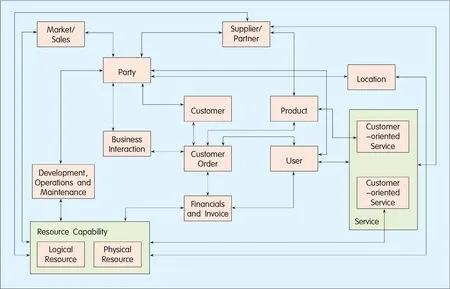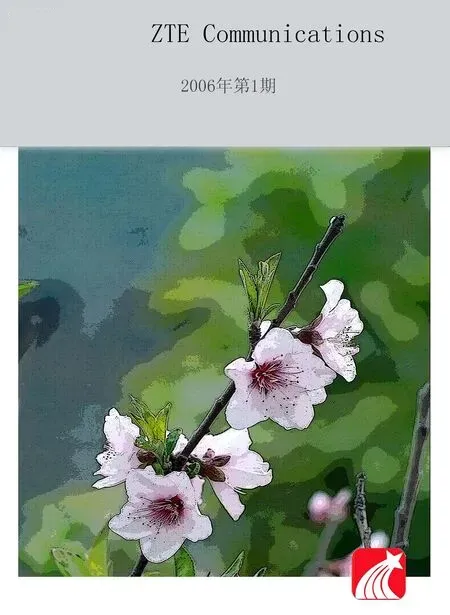Typical OSS Implementation and Application
Peng ChaobaoChen YiWujieru
(1. Guoxin Lucent Technologies, Shanghai 200127, China;
2. Lucent China, Beijing 100738, China)
AbstractThe continuous changes of clients'demands,operators'organizational structures and software implementation technologies make it difficult to form a steady Operations Support System(OSS).Therefore,it is important to find relatively steady factors for an OSS.The Next Generation Operations System and Software(NGOSS)program of TeleManagement Forum(TMF)deeply studied the regular factors,and the core concepts,methodology and repository of NGOSS reflect the study achievements.This paper uses the implementation of order management and service provisioning system in the OSS to discusses how to develop an OSS by the NGOSS concepts and tools.It also points out that the implementation of such an OSS should take the characteristics of telecom operator products,services and resources,and specific software implementation technologies into account.
T here are many changeable factors in the Business Support Systems(BSS)and Operations Support Systems(OSS),such as technical improvement,innovated services,changeable products combinations,differentiation of customer demands and business process of operators,different operators'organizational structures,and changeable software implementation technologies.These factors make it difficult to form a steady OSS.For building a BSSand OSS,it is important to find relatively steady factors.Operators,integrators and software vendors on the OSSvalue chain are always looking for these steady factors.TeleManagement Forum(TMF)deeply studied the regular factors,and reflects the study achievements in the core concepts,methodology and repository of its Next Generation Operations System and Software(NGOSS).
Chinese operators and related vendors should focus on the study of and make solutions to these problems:how to deeply understand the core concepts and tools of TMFNGOSS;how to follow TMFNGOSSwhen conducting practical OSSsystem planning,software design and system integration;how to adapt to changeable external environments.
1 Concepts and Methodology of OSS
Although NGOSSwas initiated and is promoted by TMF,it is actually an organic integration of the concepts from telecom management,enterprise management and business process management,as well as from Commercial Off-The-Shelf Software(COTS)(as shown in Figure 1).NGOSS abstracts three stable elements:the Business Process Management(BPM)-enhanced Telecom Operations Map(eTOM),Shared Information/Data(SID)model and NGOSSarchitecture.
Integrating the idea of the hierarchy of the Telecom Management Network(TMN)and concepts of business process management,the eTOM delivers an end-to-end customer-oriented holistic process framework at the enterprise management level.Moreover,the enterprise interior management process is also brought into eTOM.

▲Figure 1. Concepts of NGOSS.
The SID modeldelivers a holistic information framework for telecommunications operations,emphasizing that information sharing should be an overall concept and implemented through the whole process of system planning,design,fulfillment,integration and deployment.It radically solves the problem of information“islands”.

▲Figure 2. NGOSS tools and lifecycle.
NGOSSfully absorbs the concepts of COTS,and is dedicated to create COTS applicable to telecom operations on the basis of BPM and SID.
TMFdefines 4 NGOSSlifecycle views:Business,System,Implementation and Deployment.It also defines 4 instructive documents:eTOM[1],SID Model[2,3],Technology Neutral Architecture(TNA)[4],and Compliance Testing Tools[5].
The business view describes challenges the telecom industry is facing,as well as the requirements of telecom operations support systems.The system view defines the business solution.The solution building process is described in the implementation view.Finally,the deployment view gives deployment and use of the solution.
Figure 2 depicts management of the NGOSSlifecycle and tool documents.The eTOM spans the business and system views,SID spans the business,system and implementation views,TNA spans the system and implementation,and Compliance Testing spans all 4 views.
1.1 eTOM
TMFuses the eTOM to depict the main process frameworks of telecom operations,as shown in Figure 3.From an overall conceptual level,the eTOM is divided into 3 parts:strategy,infrastructure and product,operations,and enterprise management.The strategy,infrastructure and product,and operations are horizontally divided into the market,product,customer,services,resource,and supplier and partner levels,and longitudinally into 7 process groups:strategy and commit,infrastructure lifecycle management,product lifecycle management,operations support and readiness,fulfillment,assurance,and billing.Each process is further fractionalized through the intersection of the horizontallevels and the longitudinal process groups.
As a process framework,the eTOM reflects the process of common telecom operations.Analyzing operations to different levels of detail,the eTOM presents a view with multiple levels.The eTOM business process framework delivers the functions OSSsoftware should fulfill.It is a stable functionality framework for the fulfillment of OSSCOTS.
The eTOM has 4 framework features.First,it uses static process elements to constitute dynamic processes.Second,it is independent of specific products,services and resources.Third,it is independent of organization structures.Last,it decomposes the processes.The horizontal and customer-oriented longitudinal division creates holistic fluidity to some extent.
But from the micro point of view(sub-processes),eTOM provides an aggregation of static sub-processes.Practical operations are too complex to use assured processes to describe,therefore,the description with static processes brings changeable real operation processes with space for free process building.The eTOM uses an example of the process the flow of the Digital Subscriber Line(DSL)system commissioning in its appendix to help people understand how to apply the sub-processes in the business process framework to fulfill dynamic processes.In practical processes,changeable products,services and resources lead to different flows of specific processes.eTOM,independent of organization structures,is adaptable to different organization structures.Decomposition of the business process presents the eTOM's framework feature of process fractionizing.
1.2 SID Model

▲Figure 3. eTOM framework.
The SID model provides operators,system integrators and software vendors with common concepts and languages for telecom operations.

▲Figure 4. SID framework.

▲Figure 5.Relationship of BSSand OSSdomains.
The top-level domain division of SID is consistent with the domain division and horizontaldivision of the business process in the eTOM.SID is divided into the market,selling,product,customer,service,resource,supplier/partner,enterprise and public business entity domains.Similar to the eTOM,SID may be decomposed level by level,which is also related to service processes.
The SID framework can be inherited and developed.Therefore,the framework features of SID,just like domain-specific“blades”,may make ongoing developments,as shown in Figure 4.This solves the problem of diversity of services and resources.
Figure 5 shows the relationship between BSSand OSSdomains.This is the primary relationship between basic entities of an information model.In addition,this relationship offers a basic factual model for the definition of business rules.
1.3 NGOSS Architecture
NGOSSarchitecture is divided into SID,security,policy,business process,and applications and service,as shown in Figure 6.The 5 parts of NGOSS architecture have a relationship in which they support and serve one another.SID is the basic part.The other parts are based on SID,and it is necessary to use models to define them.The relationship of main domains in SID is as depicted in Figure 5,which is the factual model for business rules management[6].The business model is the basis of business rule definition in policy management.NGOSSemphasizes the importance of policy management.NGOSSpays attention to separate specific process control with applications,in order to avoid the impact of process changes on application software.As for applications,NGOSSfocuses on using Web service mechanism to fulfill application software.
2 Fulfillment and Application of Order Management System
This article takes the order management system of OSSas an example to analyze how to use NGOSSconcepts and tools to fulfill the order management system,and how to meet the requirements brought by the aforementioned changeable factors.The order system aims at fulfilling commissioning process management,order handling,service configuration and activation.It is built through 4 steps:process and function frameworks creation,SID model creation,system architecture building,and system deployment and personalized creation.
2.1 Process Framework and Function Framework
In the process framework,the ordermanagement system is positioned to handle customer interface management,order handling,service configuration and activation,resource configuration and allocation,and Supplier/Partner(S/P)relationship management.These 5 sub-processes compose the process framework of the order management system,as shown in Figure 7.

Figure 6.▶NGOSS architecture.

▲Figure 7. Process framework of order management, and service configuration and activation.
The order management system implements two types of functions.The first type is the management of end-to-end processes,which includes process management composed of 5 sub-processes.The other one is support of order management,service configuration and service activation.Customer interface management,resource configuration and allocation,and S/Prelationship management are fulfilled by other systems.Figure 8 depicts the function framework of the order management system.
The function framework supports the process framework.It supports the building and scheduling of specific processes by process management.Each function sub-module itself is also a framework,supporting different products,services and resources.Each function module provides a basic element of the process,and the specific division of process activities is related to the division of products,services and resources.
2.2 SID Model
The SID model of the order management system follows the NGOSSframework.Its relationship framework of customers,products,services and resources follows the process framework shown in Figure 7.According to the SID modeland its subdivided models,the system makes the subdivision of specific products,services and resources.It is notable that the shared data of SID need keep consistency with those of Customer Relationship Management(CRM)and resource systems.
2.3 System Architecture
The architecture of the order management system follows the NGOSS concepts.It is implemented by J2EE software architecture.As shown in Figure 9,the architecture is divided into the data,information service,service logic,and control layers.In order to support model changes,the data layer need supporting metadata.The information service layer encapsulates information to offer a basic information service.The service logic layer conducts encapsulation through its components that are divided into service and presentation sub-layers.The control layer abstracts service rules and puts them into strategy management to meet the requirements of service rule creation.Separated from other application modules,the functions of service process are implemented at the process management module,which lessens the impacts on application functions.

▲Figure 8. Function framework of order mangement system.

◀Figure 9.Architecture of order management system.
2.4 System Deployment and Personalized Creation
System deployment of the order management system mainly considers the linkage of the system with other systems,including process,data and function linkages.Different system architecture will directly influence system deployment.Multi-level architecture may lead to multi-level system deployment.Accordingly,besides integration of the order management system and CRM and resource systems,integration of systems at different levels should also be considered.Acustomer process is always going through multiple systems of the same type at different levels.
As for COTSfor order management and service configuration,there is much work on personalized creation during system deployment.For example,COTS creates specific processes that meet the demands of operators,as well as a fulfillment process for new products.
3 Conclusions
Chinese operators and vendors greatly concern OSSCOTS.Offering the business process framework,SID and TNA,TMFNGOSSmethodology defines basic requirements on the business process framework,data framework and system architecture for creating OSS COTS.The characteristics of telecom products,services and resources,and specific technologies for software fulfillment should also be considered in the fulfillment and application of OSS COTS.Certainly,there are other factors in OSS,software engineering,and software technologies that need further research.

